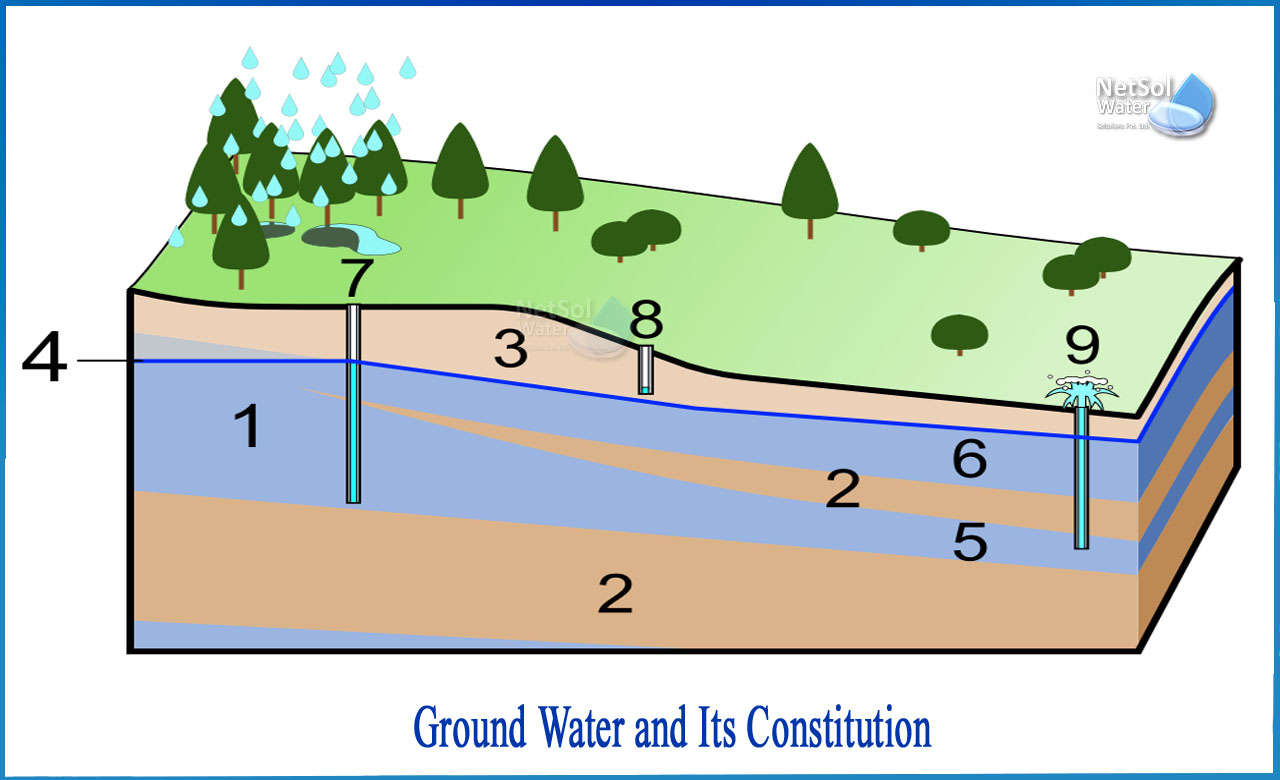What is groundwater?
Groundwater is the water found under the Earth's surface in the pore spaces of rocks and soils, as well as in the cracks of rock formations.
What is an aquifer?
When a unit of rock or an unconsolidated deposit can produce useable amounts of water, it is referred to as an aquifer.
What is water table?
The water table is the depth at which soil pore pores or cracks and holes in rock become entirely saturated with water.
Groundwater is replenished from the surface; it may release spontaneously from the surface in springs and seeps, forming oasis or wetlands. Groundwater is often removed for agricultural, municipal, and industrial purposes through the construction and operation of extraction wells.
What is Ground water and its constitution?
Nearly 95 percent of the nation's fresh water supplies are derived from groundwater. It can remain underground for hundreds of thousands of years, or it might rise to the surface and contribute to the filling of rivers, streams, lakes, ponds, and wetlands. Groundwater can either be pumped from a well or come to the surface as a spring. Both of these are standard methods for obtaining groundwater for drinking.
Groundwater accounts for over half of our municipal, household, and agricultural water supply. Groundwater is held in the microscopic voids between rock and sand, soil, and gravel. The size of the rock particles determines how effectively loosely organized rock (such as sand and gravel) retains water. Layers of loosely distributed particles of uniform size (such as sand) tend to contain more water than layers of rock of varying sizes.This is due to the fact that smaller rock materials settle in the crevices between bigger rock materials, reducing the amount of open area that can contain water. The form of rock particles influences porosity (how effectively a rock material stores water).
Round particles pack more firmly than sharp-edged particles. Material with angular edges has more free area and so can store more water. There are two zones of groundwater. Water and air are found in the open spaces, or pores, of the unsaturated zone, which is directly under the ground surface. The saturated zone, which contains water in all of the pores and rock cracks, is underneath the unsaturated zone. The water table is located at the top of the saturated zone. The water table might be a few feet or hundreds of feet below the ground surface.
How is water circulated?
Surface water and groundwater are both components of the hydrologic cycle, which is the continuous movement of water above, on, and beneath the earth's surface. The cycle has no origin and no conclusion, but it is best understood by tracing it back to precipitation.
What is precipitation?
Precipitation takes several forms, including rain, snow, and hail. Rain, for example, moistens the earth. Water continues to trickle into the earth as additional rain falls. The pace at which water soaks into or infiltrates the soil is determined by soil type, land use, and the severity and duration of the storm. Water infiltrates faster into sand-dominated soils than into clay- or silt-dominated soils.
There is hardly no water that filters into pavement areas. Runoff streams arise when rain that cannot be absorbed by the ground gathers on the surface.When the soil is totally saturated, more water gently travels down from the unsaturated zone to the saturated zone, refilling or recharging the groundwater. Water then flows through the saturated zone to discharge locations for groundwater.
What is evaporation?
When water from surfaces such as oceans, rivers, and glaciers is turned to vapor, this is referred to as evaporation. Evaporation, together with plant transpiration, rises above the Earth's surface, condenses, and creates clouds. Water from both runoff and groundwater release flows into streams and rivers, finally reaching the ocean. Oceans are the greatest bodies of surface water that contribute to evaporation.
Pollution of Ground Water
The most common cause of groundwater contamination is inappropriate garbage disposal on land.Chemicals and rubbish dumps, industrial waste lagoons, tailings and process wastewater from mines, oil field brine pits, leaky underground oil storage tanks and pipelines, sewage sludge, and septic systems are major sources. To establish the amount of contamination and to help in the design of groundwater remediation systems, polluted groundwater is mapped by sampling soils and groundwater near suspected or known sources of pollution.
Conclusion
Ground water is just as important as fresh water for human usage. Everyone's primary priority should be to save ground water.
Netsol Water is India's leading manufacturer of water treatment systems. We not only supply the greatest treatment plants, but we also modify them to meet the needs of our clients.



